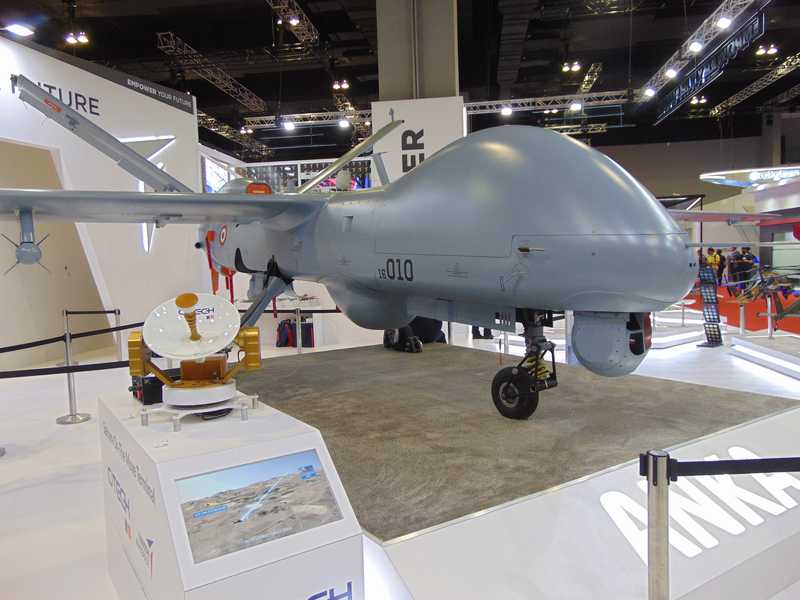Anka-S (pictured at DSA 2022) is being offered to meet a Malaysian requirement for three MALE UAVs capable of undertaking ISR missions. (Photo: Dzirhan Mahadzir)
Turkish Aerospace (TAI) is committed to carrying out industrial partnerships in Malaysia even if its bids are not selected for Malaysia’s Medium Altitude Long Endurance (MALE) UAV and Light Combat Aircraft (LCA) programmes, company officials said during the Defence Services Asia (DSA) 2022 exhibition in Kuala Lumpur.
Turkish Aerospace is offering the Anka-S UAV to meet a Malaysian requirement for three MALE UAVs and the Hürjet for Malaysia’s 18-aircraft LCA programme to replace Aermacchi MB-339CM trainers and BAE Hawk 100/200s that the Royal Malaysian Air Force operates in trainer and light combat roles.
EVP for aircraft Atilla Dogan and Omer Yildiz, EVP for UAVs, told Shephard in a joint interview on 29 March that even if TAI is unsuccessful in its bids, its efforts to build an industrial presence in Malaysia will continue regardless of the outcome of the tenders.
‘Our Malaysian initiatives are not tied to the tenders; regardless of the outcome of the tender process, we feel that Malaysia has a lot to offer to Turkey and Turkish Aerospace products,’ said Dogan. ‘We want to establish long-term relationships in Malaysia regardless if we are awarded or not. We want to be here.’
TAI president and CEO Temel Kotil stated in a release on 29 March: ‘We opened an engineering office in Cyberjaya and currently we have 15 engineers. We are targeting to reach 100 engineers by the end of the year to design and build the avionic systems for Turkish Aerospace.’
With regards to Hürjet, Kotil added that TAI is delivering 16 aircraft to the Turkish Air Force from 2025 onwards.
‘We offer business models that allow any system to be integrated,’ he noted. ‘We could localise Hürjet with a partnership of 50-50 percent joint company. Avionics is all Turkish-built by Aselsan, but we want to design for international markets in Malaysia.’
Dogan said that TAI had established a wholly owned subsidiary company in Malaysia, with the initial focus on avionics because Malaysia has a strong electronics sector with human resources.
However, TAI does not expect its Malaysian subsidiary to generate additional business but instead to receive work from Turkey, which will enable the company to develop to an extent where it would be able to provide avionics and software for the Hürjet, not only for the potential Malaysian order but also for Hürjets sold by Turkey to other countries.
‘Some of the avionics equipment and some of the software will be coming from Malaysia,’ Dogan noted.
He added that TAI in its tender proposal offered to build the first three aircraft in Turkey, with Malaysian engineers and technicians being trained so that the remaining 15 aircraft can be manufactured and finally assembled in Malaysia.
At the same time, the Turkish OEM will provide Malaysia with the capabilities and skills to establish in-country MRO and training facilities for the Hürjet.
No final decision has been made on where the manufacturing facility will be or which Malaysian company TAI might partner with.
‘We are in the process of understanding the industrial ecosystem in Malaysia, and when the time comes, we will choose a partner or multiple partners depending on the[ir] capabilities and interests,’ said Dogan.
He said that the Malaysian RfP called for the LCA to be delivered in 2025, a date which the Hürjet will be able to meet. A complete training package is included with pilots and maintenance crews to be trained in Turkey.
Yildiz remarked that the tender process is ongoing, but TAI will continue collaborating with its Malaysian partner Deftech on the Anka-S regardless of the result.
Malaysian requirements called for one main base plus six forward operating stations for three UAVs along with a satellite link capability, though this link has not been tied to any specific satellite.
Anka-S can be armed but the Malaysian requirement is for a pure ISR capability.


